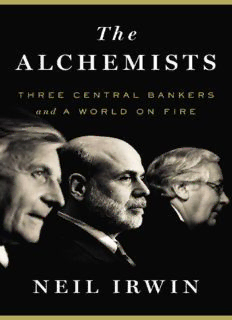Table Of ContentTHE PENGUIN PRESS
Published by the Penguin Group Penguin Group (USA) Inc., 375 Hudson Street, New York, New York
10014, USA
USA • Canada • UK • Ireland • Australia • New Zealand • India • South Africa • China Penguin Books Ltd,
Registered Offices:
80 Strand, London WC2R 0RL, England
For more information about the Penguin Group visit penguin.com Copyright © Neil Irwin, 2013
All rights reserved. No part of this book may be reproduced, scanned, or distributed in any printed or
electronic form without permission. Please do not participate in or encourage piracy of copyrighted
materials in violation of the author’s rights. Purchase only authorized editions.
Photograph credits appear here.
ISBN 978-1-10160580-6
To my parents, Co and Nancy Irwin
Contents
Title Page
Copyright
Dedication
Time Line
Introduction: Opening the Spigot
Part I:
RISE OF THE ALCHEMISTS, 1656–2006
ONE. Johan Palmstruch and the Birth of Central Banking
TWO. Lombard Street, Rule Britannia, and Bagehot’s Dictum
THREE. The First Name Club
FOUR. Madness, Nightmare, Desperation, Chaos: When Central Banking Goes
Wrong, in Two Acts
FIVE. The Anguish of Arthur Burns
SIX. Spinning the Roulette Wheel in Maastricht
SEVEN. Masaru Hayami, Tomato Ketchup, and the Agony of ZIRP
EIGHT. The Jackson Hole Consensus and the Great Moderation
Part II:
PANIC, 2007–2008
NINE. The Committee of Three
TEN. Over by Christmas
ELEVEN. A Wall of Money
Part III:
AFTERMATH, 2009–2010
TWELVE. The Battle for the Fed
THIRTEEN. The New Greek Odyssey
FOURTEEN. The King’s Speech
FIFTEEN. The Perilous Maiden Voyage of the QE2
Part IV:
THE SECOND WAVE, 2011–2012
SIXTEEN. The Chopper, the Troika, and the Deauville Debacle
SEVENTEEN. The President of Europe
EIGHTEEN. Escape Velocity
NINETEEN. Super Mario World
TWENTY. Governor Zhou’s Chinese Medicine
AFTERWORD: Back to Jackson
Photographs
Acknowledgments
A Note on Sources
Notes
Image Credits
Index
Time Line
November 30, 1656—Johan Palmstruch’s Stockholms Banco is chartered by
Swedish king Karl X Gustav.
1661—Stockholms Banco issues the first paper banknotes in Europe.
September 17, 1668—After Stockholms Banco collapses, the Swedish
Riksbank is created. It remains the country’s central bank until this day.
July 27, 1694—King William III charters the Bank of England.
May 10, 1866—British bank Overend, Gurney & Co. fails, sparking a panic in
the London money markets. The Bank of England floods the banking system
with liquidity, acting as lender of last resort.
Fall, 1907—A banking panic in New York sparks a global economic downturn,
crystallizing the need for a central bank in the United States.
December 23, 1913—The Federal Reserve Act passes, setting up a central bank
for the United States, albeit one with a complicated structure of twelve powerful
regional branches.
1923—The German Reichsbank, led by Rudolf von Havenstein, prints massive
amounts of money, resulting in hyperinflation. Price increases of thousands of
percent per month destabilize the war-ravaged nation and spark uprisings by the
Nazis and other insurgent groups.
November 16, 1923—Hjalmar Schacht introduces a new and more stable
German currency, the rentenmark. Its value is set at one rentenmark per trillion
reichsmarks.
October 29, 1929—The U.S. stock market crashes on “Black Tuesday.”
May 11, 1931—Credit-Anstalt, a leading Austrian bank, fails, prompting a
ripple effect of withdrawals and more bank failures in Germany and elsewhere in
Europe.
July 9, 1931—Hans Luther, head of the German Reichsbank, travels to
European capitals and then to meet fellow central bankers in Basel, looking in
vain for international relief from the growing banking crisis.
September 21, 1931—Britain leaves the gold standard, facing economic
collapse should it try to maintain the peg of the pound to the price of gold.
July 22, 1944—Global economic leaders finish a conference in Bretton Woods,
New Hampshire, where they agree to a world economic order for the post–
World War II globe.
August 15, 1971—With the United States struggling to maintain the peg of the
dollar to gold as mandated by the Bretton Woods system, President Richard
Nixon suspends the gold window. His advisers include Federal Reserve
chairman Arthur Burns and Treasury official Paul Volcker.
1978—In Arthur Burns’s final year as Federal Reserve chair, inflation reaches 9
percent.
October 6, 1979—In an unscheduled Saturday meeting of Fed policymakers,
new chairman Paul Volcker engineers an interest rate hike and a new strategy to
tighten the money supply, aiming to bring down inflation. These rate hikes lead
to a deep recession, but eventually end the inflation that took root under Burns.
December 10, 1991—European leaders agree to the Maastricht Treaty, pledging
to create a common currency.
June 1, 1998—The European Central Bank is created to administer the euro.
March 19, 2001—Suffering economic stagnation in the wake of a real estate
and banking system collapse, the Bank of Japan begins a program of buying
assets, known as quantitative easing.
July 1, 2003—Mervyn King takes office as 119th governor of the Bank of
England.
November 1, 2003—Jean-Claude Trichet takes office as second president of the
European Central Bank.

